Back from the black: rebuilding the Southern Ocean Lodge hotel
Their luxury Kangaroo Island lodge was razed three years ago. Now James and Hayley Baillie are rebuilding – in an innovative, bushfire-smart way.
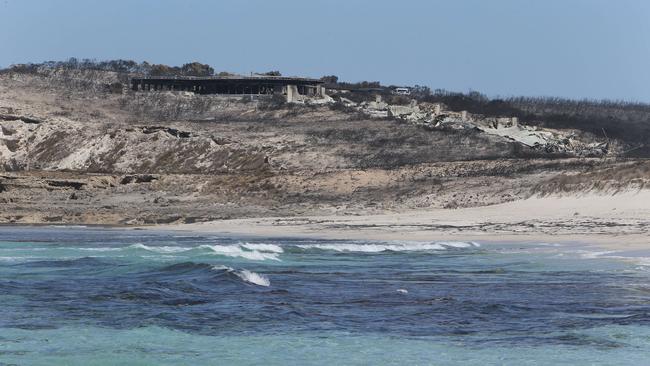
It’s early January 2020 when James Baillie arrives at the twisted steel and smouldering timber mess that had been the luxurious Southern Ocean Lodge on Kangaroo Island. He follows the path of a 300m boardwalk that had spanned the length of the luxury resort he had created with his wife Hayley. The timber planks are mostly gone, devoured by the monster bushfire that had roared through the property’s 102ha of eucalyptus and melaleuca scrub three days before, but a trail of steel screws leads the way. Up ahead, he sees something that has miraculously survived the blaze. There, on a little terrace overlooking the ocean, is a beautiful ceramic table.
“It was still intact until we got there,” Baillie says, recalling that awful day. “And then as we went down to the beach, the fire engulfed the pottery chairs and table and it literally exploded while we were there. I didn’t know whether to laugh or cry.”
Michael Moret-Lalli, executive chairman of Baillie Lodges, who was also there that day, adds: “It was like it had waited for James to get there before the last little bit went up in flames.”
The Baillies had taken a big risk to build a high-end resort with just 21 suites in such an isolated spot off the South Australian coast, and many people questioned if it would work – especially with tariffs at thousands of dollars a night. But when guests like Bill and Melinda Gates turned up, they proved the naysayers wrong.
Then, 12 years after opening and freshly named as the top hotel in the Asia Pacific by Travel + Leisure magazine, it was gone. “Because it was something that we’d built from scratch, the feeling of loss was immense,” says James. “And, you know, for days afterwards on Kangaroo Island I’d go for a walk or a run and actually burst into tears.”
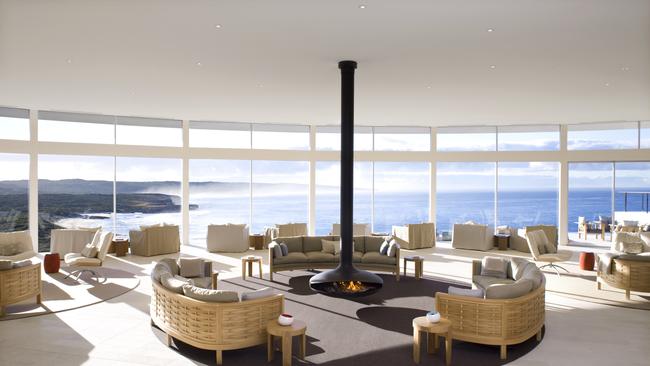
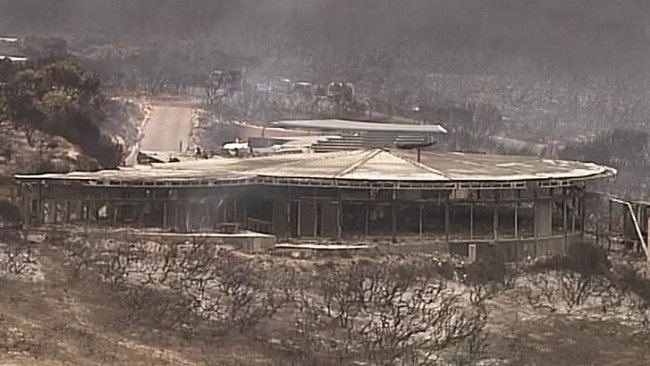
But if the burning table was nature’s warning to try somewhere else, the couple had no intention of listening. “It was almost, to me, setting a challenge,” Baillie says. “You saved that to the very end – you know, you can go screw yourself, we’re going to bring this back.”
Today, out of those ashes, the steel and timber skeleton of a new resort is snaking up a ridge on the island’s southern side. The only remnant of the old one is the curved concrete slab of the spectacular common room where guests sat, read, dined and drank while enjoying a panorama of ocean and clifftops. That view is why Baillie Lodges is spending $50m to try its luck again. To the south, where the next stop is Antarctica, the big rollers sweep in, sending spray high onto those cliffs; to the north, mallee, wattle and tea tree spread to the horizon, some branches black but many tinged with green.
Yet as climate change delivers more frequent, severe, and unpredictable events from bushfires to cyclones and floods, can anyone really rebuild safely – and sustainably – in wild locations like this? Can you truly stop nature if she wants to poke your eye?
“I guess you can’t get an iron-clad [guarantee] around that,” says Moret-Lalli. “You need to do these remote experiential offerings and you’ve always got some risk, whether it’s cyclones in the north on the islands and bushfires in other places. You’ve just got to be aware of the risks and mitigate as much as you can – hope for the best, plan for the worst.” And pay the insurance premium.
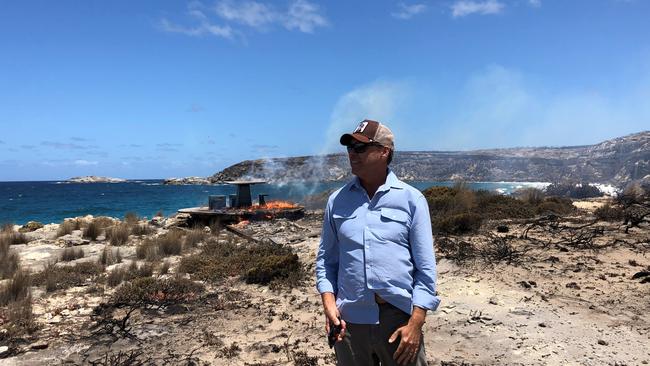
In the black summer of 2019-20, fires across five states directly killed 33 people and three billion animals while burning more than 3000 homes and 17m hectares of land – including almost half of KI and nearly all of Flinders Chase National Park, which borders Southern Ocean Lodge. With global “Australia Burns” headlines, and a guest list heavy with rich Americans and Europeans, the lodge’s owners want the resort, scheduled to open in November, to show they have taken climate change seriously.
Locals hope it works. The international marketing of the lodge boosted KI’s profile, drew in more tourists, and gave what the Baillies claim was a $10m annual benefit for the island. “I think Southern Ocean Lodge was like a poster child for the Australian bushfires to a degree, it [the destruction] was beamed around all over the world,” Moret-Lalli says. “I think there’s a great opportunity to lead with that and be a bit of a benchmark.” Indeed, The New York Times recently listed Kangaroo Island at number seven on its top 50 places to visit in 2023, noting the Lodge would be back “grander and better”.
It’s certainly bigger, which makes the climate element critical in the redesign by original architect Max Pritchard, who was born on KI. There will be wider ocean views from the suites, new swimming pools and a four-bedroom hilltop pavilion. But will it stop another fire, and does it cut its own contribution to global warming?
Native juniper grows wild across the cliffs overlooking the Southern Ocean, thriving in winter’s wild winds and summer’s scorching heat. It’s a handsome coastal bush with fleshy green leaves and tart purple berries that admirers say make delicious jams and preserves. And, spruiks Hayley Baillie, it also helps make a very tasty gin that guests would sip in luxury at the old lodge.
Baillie, fresh from a walk on the beach path she first used to explore the site 20 years ago, loves stories like that because they go to the heart of what people enjoy about travel: making connections, sometimes surprising, with the environment around them.
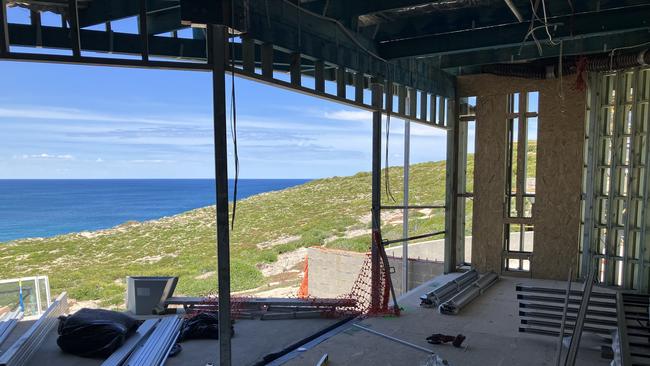
People want more than a bed to sleep in, says Baillie, who learnt her business taking wealthy Americans on expedition ships: they need to leave enriched and educated by the experience. KI is “Australia’s Galapagos, a zoo without borders”, so a big part of that experience is the natural flora and fauna – much of which is still recovering three years after the fires.
But native juniper, or coastal boobialla, is about to move beyond just flavouring guests’ evening gin and tonic. It is being enlisted to help keep them safer. “The native juniper is a fire-retardant type of bush,” Baillie says. “And it’s going to be planted as part of a protective barrier around the lodge. I mean, what a great story – having a Baillies 9 gin while watching the native juniper growing right in front of you.”
It turns out that just as some native plants fuel bushfires with the oils they carry, others can help slow them because of the water their leaves hold.

Pritchard explains that when building the first lodge, the bush had been left as untouched as possible. That made it vulnerable, as the Baillies discovered back in December 2007, months before the Lodge opened, when bushfires closed in on the almost-completed resort that did not yet have its fire suppression system activated. A fortunate wind change helped save the day.
But the risk from being so close to nature didn’t go away. “The consequence was we had very flammable eucalyptus and melaleuca, right against the building,” says Pritchard. “And with the extent of that fire, that was just too much.”
James Baillie thinks that even if the resort had been a substantial distance from the scrub it still would have burnt that day. It was 1000C, an unstoppable firestorm, and “a 20m setback, or a 2km setback, I don’t believe would have saved it”.
Even so, this time the South Australian Country Fire Service has called for a 20m vegetation management zone around the buildings, which means cutting back the coastal scrub to reduce the impact of radiant heat. But lawn or bare ground is not the look for a wilderness resort, says Pritchard.
Adelaide revegetation expert Wayne Brown was called in six weeks after the fire to suggest an alternative. “I said, ‘I think we can rebuild the landscape’,” says Brown, who runs Environments by Design. He investigated other plants growing around the site and found a range of natives with fire-retardant qualities, their leaves storing water in the salty, sandy environment. They included pigface, coastal saltbush from nearby Hanson Bay, coastal fan flower, sea berry saltbush, creeping boobialla and the larger upright variety of boobialla, also known as native juniper. They could all be propagated by cuttings rather than seeds, and the lodge’s staff village now has greenhouses and nurseries where thousands of cuttings are in various stages of growth. “I had to train up a couple of people to understand how to grow the plants,” Brown says. “We’ll be finished in about March, ready for planting in June or July.”
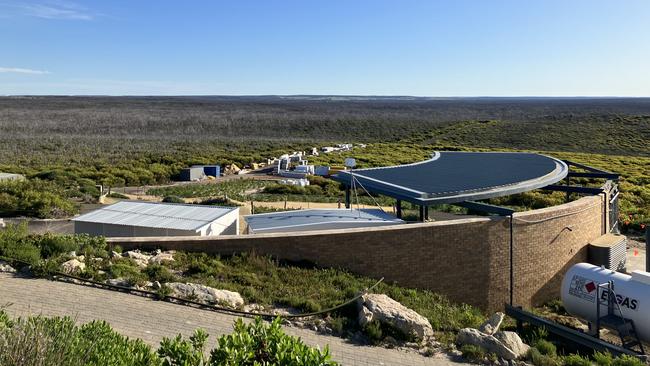
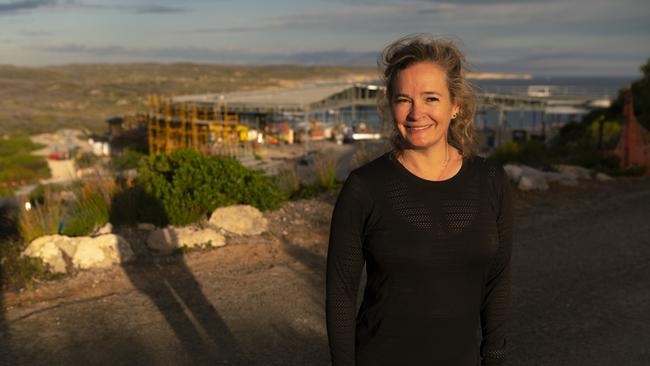
Around the lodge, a 3m bare zone of crushed limestone beside the building will be surrounded by a defensive ring of 25,000 natives comprising up to 15 species. The plants will form a mosaic with no continuous line for fire to travel. Flat groundcovers such as pigface and creeping boobialla will be planted closer to the building, with the height of the plants rising gradually to native juniper, which grows to 3m or more, mixed with the eucalyptus and melaleucas. “This is definitely new, and it’s challenging,” says Brown. “It’s world class. This is showcase, there’s no doubt about that.”
Keeping back the flames is crucial, but only one element of the danger. As lodge managers John Hird and Alison Heath learnt late in the afternoon of January 3, 2020, airborne embers that can fly 30km on strong winds are another threat. The couple had stayed with four staff to start the resort’s bushfire sprinkler system, having sent their guests away earlier in the day. Hird watched from a roof in the staff village as the fire approached. The sky over the sea behind was bright blue; in front it was dark. He watched embers start spot fires in the nearby Kelly Hill Conservation Park and “that’s when I knew we were in trouble”.
“It’s like curtains,” he recalls of the smoke. “So you have this black curtain that’s moving slowly towards you. And it opens and behind it are flames – 100m-high flames – and then the curtain closes again.” And then it hit, “like a white, rolling cloud that was going up into the heavens, and somebody had thrown a whole load of magnesium flares on the ground because it was bright white,” he says. “And as I ran I was being spat at by embers flying at me. I just covered my eyes, got into the bunker, closed the door and that was it.”
That bunker sat beneath the great common room and had a dirt floor, block walls, and a low concrete ceiling. It was solid but not designed to keep out a fire. Hird and Heath, who happily stand in it as we talk, did not realise that at the time. Then the air was filled with the sound of roaring fire and crashing roof and walls; today it is the whine of power tools.
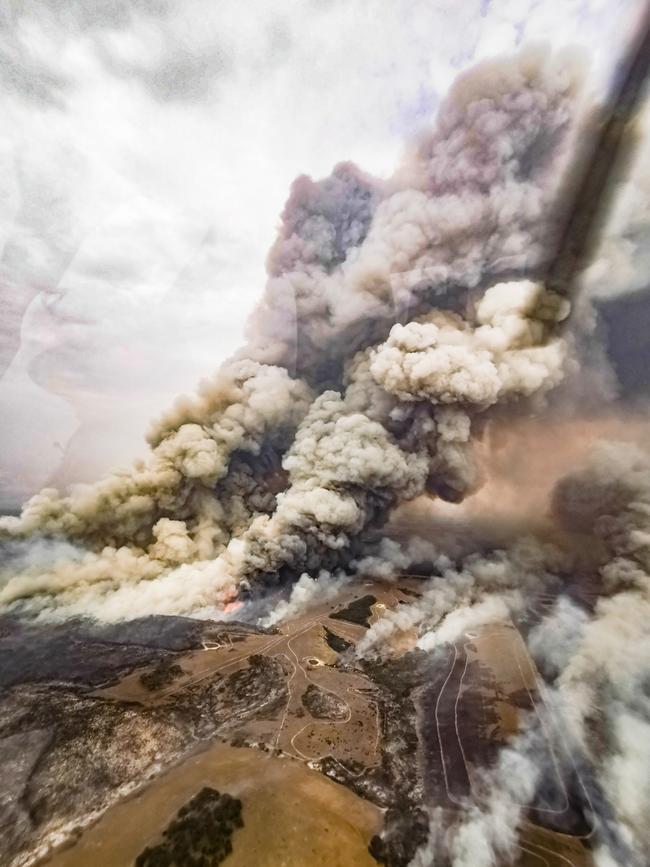
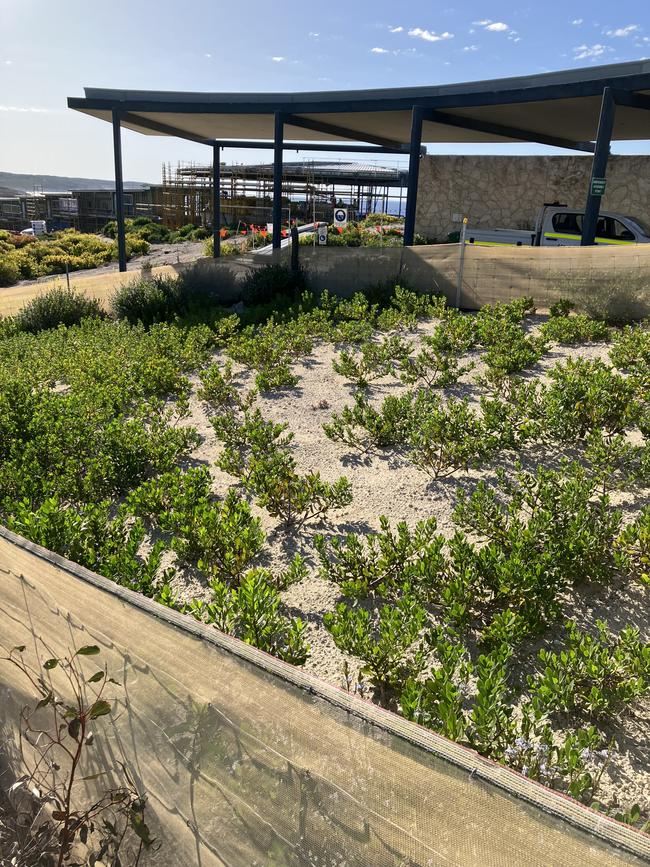
The building they were trying to save was one long line of suites climbing a ridge that rose from east to west. A corridor on the north, from where the fire came, led guests up to the great common room. The resort was far from defenceless. It had a steel roof, non-combustible cladding, and a $500,000 sprinkler system with at least 400,000 litres of water designed to flood the windows, roof and eaves, and saturate nearby bush.
The six staff stayed in the bunker for two hours as the fire moved over them five times, from all sides, roaring like a beast. Then Hird and two maintenance staff left and tried to re-enter the lodge but were driven back. “It was just an inferno roaring up the corridor,” says Hird. “So then I walked up over the hill and had a look. And I saw that the bottom [the suites lower down the ridge] had already started to collapse. There’s no way we could do anything.”
Elsewhere across the western half of Australia’s third-largest island, the fire was destroying everything before it. Two people died when their car was caught in the blaze, thousands of livestock, native animals and birds were killed, the nearby Flinders Chase National Park was turned to charcoal, and 87 homes and 210,000ha of land were razed.
Yet with its expensive fire protection system, why did Southern Ocean Lodge collapse so completely? Nobody really knows, says Matt Giltrap, who built the first resort and is construction manager on this one. The original lodge was lighter, but still had non-flammable sheeting along its sides buried in the sand to keep out embers. It is possible erosion allowed burning material into the underfloor space of the guest suites, he says. “And the guest suites were probably like a wick for the rest of the fire.” While it is only supposition, it would fit with what Hird saw. The collapse of the lower suites suggested the fire started at the bottom of the hill.
Erosion may have compromised the fire system as well. Giltrap says water mains were buried under the sand to supply the sprinklers, but over time some of the pipes might have become exposed. “And when the fire came it probably struck some of those pipes,” he says. “It would have got into the fire mains, which were PVC and they would have melted. It would have depressurised the sprinkler system. Then the water… would have just gone into the ground.”
How crucial that might have been is impossible to know. A separate sprinkler system did continue working at the staff village, and it largely survived.
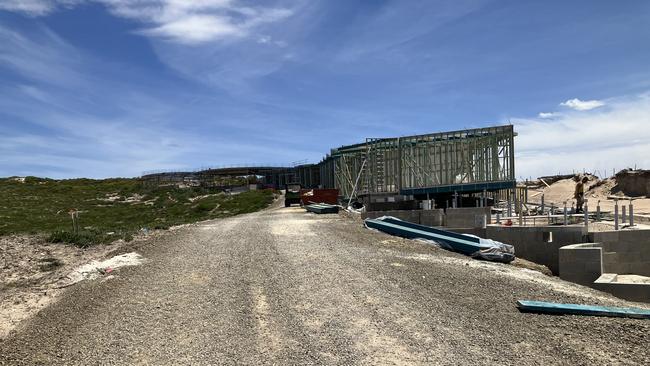
This time, the approach is different. Without knowing where the failure was, the focus is on fixing all possible weaknesses. The building meets the construction requirements of Bushfire Attack Level 29, a high risk setting where embers and burning debris are expected. Gaps larger than 2mm are not allowed.
But Giltrap says the lodge goes beyond that. The footings are concrete, steel columns support the floors, and the Besser block walls protect the underside of the building. Windows are all double-glazed. Sprinklers are not required by the code but will ring the lodge in two lines 6m and 12m from the walls, while a separate system shoots water onto the roof to wash embers back into the flooded gutter. For the first time there will be sprinklers inside. There is more water, too, up from 1.8m litres to 5.2m litres in storage tanks.
Adelaide bushfire engineer Peter Murton advised on the measures and explains that the sprinklers ringing the lodge don’t aim to wet the surrounding vegetation because strong winds in a fire blow water away. Instead, the idea is to use the wind to carry the spray onto the building, dousing airborne embers and any burning material that hits the lodge and falls to the ground where the fire-retardant natives have been planted.
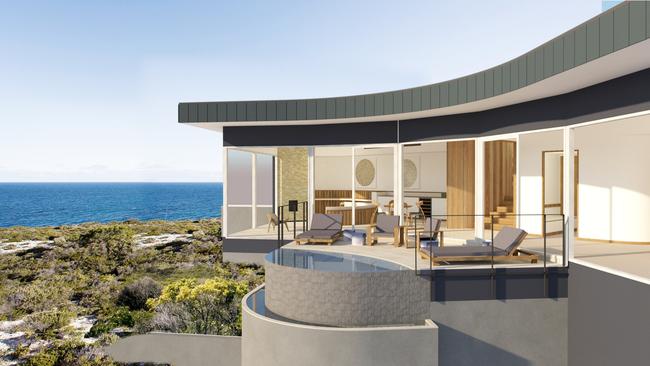
Murton says he recommended internal sprinklers in case a fire starts inside, perhaps from embers or heat breaking a window. In any case, he says, a hot fire can start a blaze inside even if the glass does not break. The double glazing will be a significant barrier to that.
There will be no fire bunker. SA’s Country Fire Service has insisted nobody should stay in a future fire, so sprinklers will be turned on remotely, using cameras to track any fire.
Is it green enough? If climate change is causing more intense bushfires, the new lodge needs to show it is serious about cutting emissions and minimising impact on the natural landscape. Moret-Lalli says everyone from investors to staff and guests expect the off-grid resort to tick the environmental boxes.
It will need to do more than before because guest numbers will rise about 25 per cent, from 46 to 58. The number of suites also goes up from 21 to 25, each with an eco-smart fireplace using methylated spirits, said to be more for ambience than heating. And with all rooms now having a bath, and the addition of several swimming pools, water use is forecast to rise 40 per cent to 35,000 litres a day in peak season.
Hird says reducing the resort’s carbon footprint has been a major focus and expects the new building will use less than half the diesel it did before. Solar and batteries will make up at least 55 per cent of the power supply for heating, cooling, desalination and wastewater treatment. More than 1300 solar panels generating 600kW have been added, with zinc-bromine flow batteries, storing up to 560kW, chosen ahead of more flammable lithium-ion.
Heating is underfloor using hot water from energy-efficient heat pumps, and insulation and double glazing has cut energy needs. Water comes from roof run-off and bores that require a desalination plant powered mostly by solar. The new wastewater plant disinfects using UV light not chlorine, so is safe for native plants, Hird says.
In some areas though, the lodge cannot afford to change. The Baillies honed a successful formula built around a very deliberate local look and feel, privacy, wildlife excursions, all-inclusive fine dining and drinks packages, and the informal approach of staff, who address guests by their first names.
That need for continuity is why they are still there. Before the fire, in mid-2019, the couple sold Southern Ocean Lodge to Denver-based private equity firm KSL, along with another resort, Longitude 131 at Uluru. They remained with Baillie Lodges as creative directors, and still own Capella Lodge on Lord Howe Island. KSL, which operates luxury resorts around the world, caters to tourism’s “mass affluent market” and has since brought resorts in the Barossa Valley, Daintree, New Zealand, Canada and Chile under the Baillie Lodges banner.
Moret-Lalli says it’s easy to get a resort wrong. “If you don’t get all the intangible service deliverables right, I think you’re found out pretty quickly,” he says. So, KSL asked the Baillies to help bring the new lodge back.
Almost everything needs replacing. Only two things survived: the steel fireplace that was suspended in the centre of the common room, and Sunshine the kangaroo, sculpted from farm equipment by local artist Indiana James, which lost its glass eyes.
This day Hayley has brought six Aboriginal artists from the APY Lands in northern SA to the island to find inspiration for pieces she plans to install in the new lodge. KI artists whose pieces graced the old resort have also been engaged. Janine Mackintosh is making mandalas from objects found after the fire, and Adelaide furniture designer Khai Liew has also been commissioned.
Hayley is clearly enthusiastic about filling this new canvas, even though the place has been sold. The new owners have given the Baillies free rein, and she says they are confident it will be as good or “maybe a little bit better”. So what is the key?
“The First Nations piece is really important,” she says of her approach to creating the right impact. “There’s also that local feel. If we can find somebody to make something for us that we would otherwise just go and buy off the shelf, let’s just put a bit more time and effort into finding the person to be able to commission that.”
Now that approach has been applied to bushfire defence. On the windswept sandstone cliffs overlooking the wild Southern Ocean there is nothing more local than saltbush, pigface and native juniper.

To join the conversation, please log in. Don't have an account? Register
Join the conversation, you are commenting as Logout